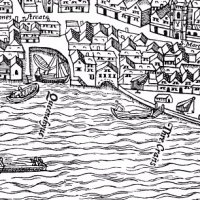
(Part 1 of three.)
Albert Einstein’s iconic equation, E = MC2, is part of his special theory of relativity. But it is also a handy summary of what happens when the physical bodies die but the soul/consciousness survives. Hence, this article’s title. ‘The afterlife Equation.’
This most famous of equations states that E, the energy content of a body (the planet Mars or a tree), is equal to its mass, M, times (or accelerated by) the velocity of light squared, C2, which is the speed of light multiplied by itself. That is 186,281.7 miles per second times 186,281.7 miles per second. Pretty darn fast.
Einstein published E = MC2 in 1905, the year he earned his doctorate in physics, without much follow-up. He focused more on developing a solid theoretical basis for his concept of relativity.
Although it may have been only of passing interest to Einstein, this equation transformed the field of physics. In one stroke, Einstein overturned a fundamental tenet that had stood since the 17th century days of Sir Isaac Newton. He held that energy and matter are separate and distinct and have no relationship to each other.
Matter and Energy
This equation states otherwise. It proposes the fundamental equivalence of matter and energy by demonstrating that they produce equivalent effects. This was Einstein's “principle of equivalence,” which states that if two phenomena produce equivalent effects, they must be different manifestations of the same fundamental law.
The equivalence principle is Einstein's most momentous conclusion. It is regarded as the foundation of modern physics. And, in the grand tradition of free inquiry and questioning everything, let us play with this tantalizing possibility: Something can go faster than the speed of light. What exactly could that something be? Could E = MC2 actually hold the key to unifying science and spirituality or even to the theory of everything (TOE)?
Please note the word here is spirituality, not religion. If science and religion ever line up on the same team, the rest of us are toast. (Dogmas backed by data? Nightmare!)
The Afterlife’s Equation - Scientific Heresy
To pose an answer, let’s commit scientific heresy (yay!) and rework E = MC2. Why not? This equation is not holy writ, even if scientists do tend to revere it and the shaggy-haired genius who first devised it. And since it’s just a bunch of variables, we are free to make those variables stand for anything we want them to represent.
We are searching for a greatly enlarged understanding of equivalence, beyond just matter and energy. To achieve this, we start by redefining all the variables except M. This variable remains the same and means mass, or matter. We need new definitions, however, for E and C2 or our equivalence principle won’t differ from the original.
Our current understanding of energy, the E in the equation, is much too limited. At present, science defines energy as the capacity for work, or the ability to do work. And that definition confines energy strictly to the material universe, cutting off any spiritual connections.
We seek a new definition of energy that transcends the limitations of the strictly material, because that new definition of energy will help explain why it’s possible to exceed the speed of light, how to unify science and spirituality, and establish a TOE.
Energy is the capacity for (the ability to) love.

This deceptively simple redefinition of energy holds profound implications. The capacity for love or the ability to love encompasses but is not limited to the ability to do work. The ability to love embraces and addresses spiritual realities in addition to the physical universe. E, defined as the ability to love, is precisely what we need in our TOE, or theory of everything.
E, then, represents the complete energy spectrum, nonphysical as well as physical. Moreover, the E in our equation also encompasses a very special type of energy: the ability to love without hindrance, limitation, or restriction. In other words, E represents the highest, widest, most powerful possible energy or ability to love, which is love unlimited by any conditions.
This E has been known by many names to many people. Scientists call it the God particle, but it is not a particle according to their understanding of such. The ancient Chinese gave it the name chi (also written as QI), and, recognizing its healing potential, made use of it through acupuncture and acupressure. The ancient Hindus named it prana, the “life force” that sustains everything.
What they’re all really talking about is unconditional love, or love without condition or limitation. E stands for unconditional love, meaning that unconditional love is the fundamental building block of the material as well as the nonmaterial universe. Furthermore, E is seamless and not divisible into ever smaller and smaller units. E is divine essence, the ultimate source of everything and the ultimate power anywhere.
A Vibrational Universal Concept

What gives E such power? To explain that requires us to recognize something that is a fundamental characteristic of E and the entire universe: It is all based on vibration.
The concept of vibration as the foundation of all realities is not new. Thousands of years ago, Heraclitus, one of the earliest known Greek philosophers, intuitively grasped this principle. He maintained that everything is constantly in flux or motion. String theory from modern particle physics states that all realities, perceptible or not, consist of the essence of strings of vibrating particles.
Vibration-based change, or what Heraclitus called flux, is the only constant in life. In other words, everything and all things, nonmaterial as well as material, are fundamentally vibrational frequencies. This is why mathematics can help us explain a great deal about our multiverse. Mathematics is the language of vibrational frequencies.
We see the physical counterpart of flux and string theory by making the simplest of observations. The weather changes. The seasons come and go in cycles. The water in the oceans constantly migrates around the globe. Out of the acorn arises the oak tree, changing greatly throughout the course of its development.
E is most powerful, then, because there are no limits to its vibrational range. There is no ending, no beginning. E, that divine essence-energy, that ultimate source, encompasses all other vibrational frequencies, meaning everything else that exists.
(Part 2’s redefinition E = MC2 explains what goes faster than the speed of light. )






































